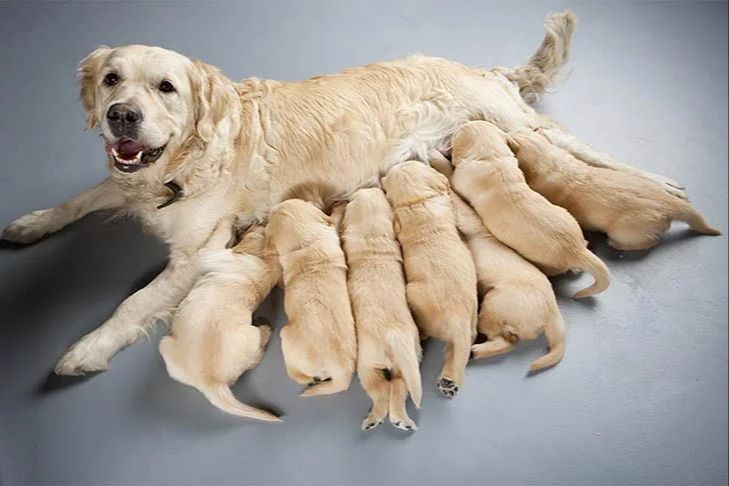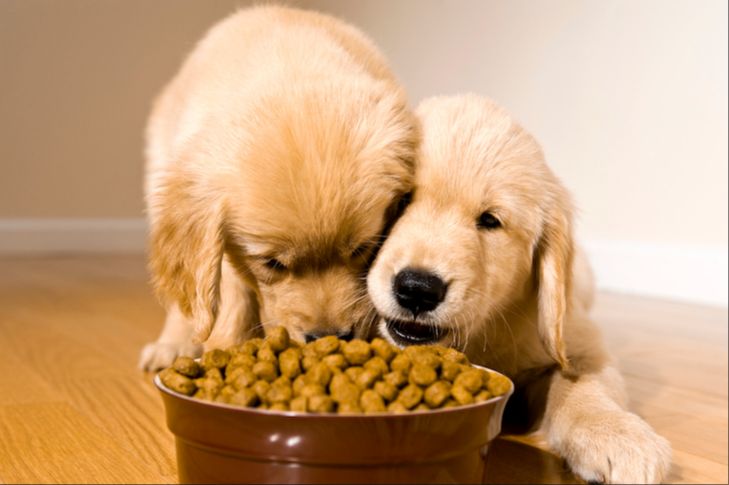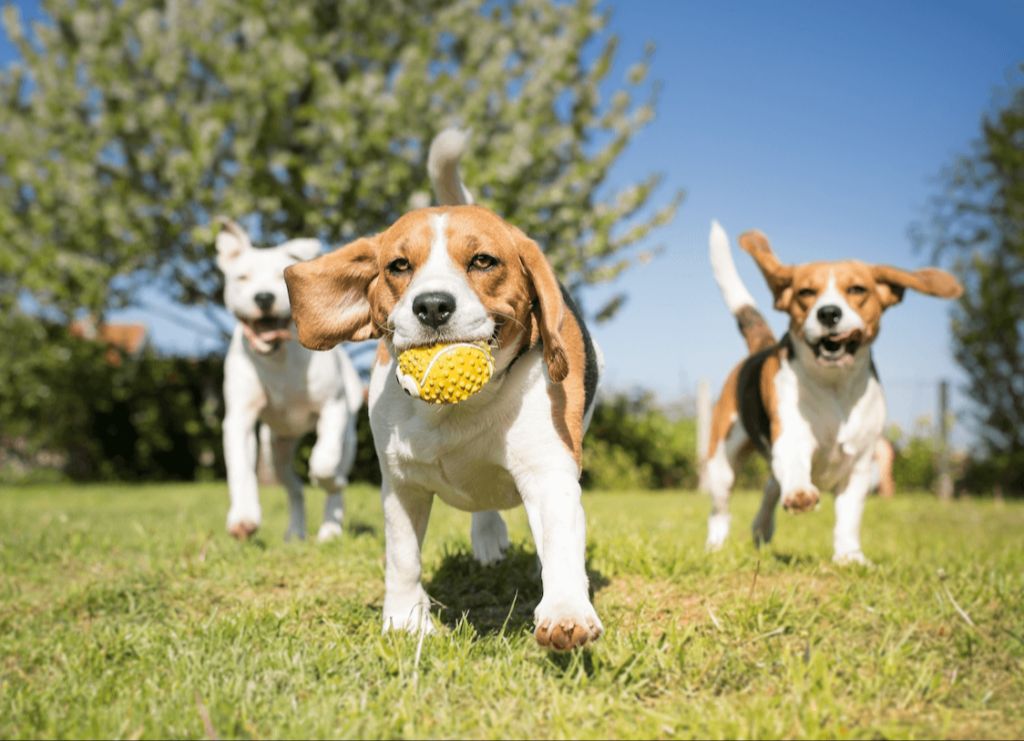Benefits of Keeping a Mother Dog and Her Puppies Together
Keeping a mother dog with her puppies for the first two to three months provides many benefits for both the puppies and their mother. Puppies should remain with their mother and littermates during this critical developmental period.
Promoting a natural weaning process is one key benefit. When allowed to wean naturally, puppies will slowly start eating solid food offered by the breeder while also continuing to nurse from mom. Abruptly separating puppies from their mother can disrupt this important transition process.
Another advantage is that puppies learn vital social skills from their mother and siblings. As quoted from this source, “The mother dog has so much to teach the new puppy.” Puppies learn how to interact with other dogs, play nicely, resolve conflicts, and interpret dog language and cues.
Staying with their mother provides comfort and reduces stress for puppies during this impressionable time. The close bond formed with their mother gives them a sense of security. Puppies feel most relaxed and confident by remaining in their familiar surroundings.
Additionally, many mother dogs feel fulfilled by caring for their puppies. Separating them too early can cause distress. Allowing her to raise her litter enables her to pass on important lessons.

Preparing for a Mother Dog and Puppies
If you know your dog will be giving birth in the coming weeks, there are several things you should do to prepare for the arrival of the puppies and properly care for the mother dog:
Set up a quiet, comfortable whelping area in an enclosed room or pen where the mother dog can give birth and care for her puppies in the first few weeks. The area should include nesting boxes and plenty of clean bedding to allow the mother dog to create a nesting area for birthing her puppies. Make sure the room is warm with a temperature around 85°F. You may need a heating pad or heat lamp for the first week or two to keep the puppies warm (source).
Gather all the supplies you will need beforehand like extra bedding, bowls for food and water, heating pads or lamps, thermometer, scale to weigh puppies, etc. You’ll also need nursing and cleaning supplies for the puppies and items to help stimulate elimination like cotton balls or towels. Stock up on high-quality puppy food for when it’s time to wean.
Childproof the whelping area as best you can by removing any clutter or toxic items. Create barriers around electrical outlets and cords. Secure any gaps so the puppies can’t crawl and get stuck somewhere.
Take the mother dog to the vet for a full checkup and to confirm pregnancy duration. Discuss any tests or supplements that may be recommended (source).
With the right set up and supplies, you can ensure the mother dog is comfortable and prepared to care for her puppies in those critical first weeks.
Caring for a Nursing Mother Dog

Providing excellent care for a nursing mother dog is crucial to help her remain healthy and produce plenty of milk for her puppies. There are several important aspects of caring for a lactating mother dog:
- Feed high-quality puppy food. Nursing requires lots of calories and nutrients, so it’s important to feed a high-protein, high-fat puppy food formula. Feed at least 50% more than usual.
- Ensure adequate water intake. Stay hydrated by providing fresh, clean water at all times. Consider adding water to her food or offering ice cubes.
- Limit stress and activity. Let mom rest as much as possible aside from nursing. Avoid too much human handling of puppies.
- Provide chew toys and mental stimulation. Peanut butter Kongs, food puzzles, and chews help relieve boredom and anxiety.
With excellent nutrition, limited stress, and proper care, mother dogs can stay healthy and care for their growing puppies (Source: https://www.akc.org/expert-advice/dog-breeding/the-care-and-feeding-of-the-breeding-bitch-part-two/). Monitoring mom’s condition and adjusting care as needed is important for her wellbeing and that of her puppies.
Weaning the Puppies
Weaning is the process of gradually transitioning puppies from their mother’s milk to solid food. It should begin when the puppies are around 3-4 weeks old, which is when their baby teeth start to erupt. The discomfort from nursing teething puppies may cause the mother dog to avoid or reject them, making this the natural time to introduce solid foods.
To start the weaning process, provide the puppies with shallow food and water bowls that allow easy access. Make sure the bowls are sturdy and won’t tip over. It’s ideal to use stainless steel bowls that are easy to clean and sanitize.
Start by offering the puppies small amounts of softened puppy kibble mixed with warm water or formula several times a day. This soft food will be easier for them to chew and digest as their teeth come in and their digestive systems develop. Gradually decrease the amount of water or formula mixed in as the weeks go by.

Continue to allow the puppies to nurse from their mother in between solid food meals. The combination of milk and solid food provides the nutrition they need for proper growth and development. As they adjust to the solid food over a period of 2-4 weeks, they will naturally nurse less and transition fully to puppy food.
According to veterinarians, the complete weaning process should finish by around 6-8 weeks old once the puppies are fully accustomed to solid food. Going slowly allows their digestive systems time to mature as you introduce new proteins and foods.[1]
[1] https://vcahospitals.com/know-your-pet/breeding-for-dog-owners-caring-from-birth-to-weaning
Keeping the Mother Dog Healthy
After giving birth, mother dogs have higher calorie needs to support milk production for nursing. It’s important to feed extra calories and provide optimal nutrition during this time. High quality puppy food or a lactation-specific diet will give the calories and nutrients needed.
In addition to extra food, mother dogs need adequate exercise and potty breaks. Take the mother dog outside to relieve herself every few hours, and provide at least short daily walks. This gives a physical and mental break from the puppies. However, the mother dog should not be separated from her puppies for more than an hour or two per day in the first weeks.
Signs of trouble to watch for after birth include mastitis (breast infection) and postpartum depression. Mastitis may cause fever, lethargy, and redness or swelling of the breasts. Postpartum depression can cause lack of interest in the puppies, pacing, and vocalizing. Contact your vet promptly if you notice any concerning symptoms in a postpartum mother dog.
Caring for Newborn Puppies
Newborn puppies require round-the-clock care and supervision in their first few weeks of life. It’s crucial to keep them warm, clean, and well-fed during this delicate time.
Puppies cannot regulate their own body temperature for the first week or two. Provide a warm whelping box filled with soft bedding and nesting material. Place a heat lamp or heating pad set to low over part of the box so they can move closer or farther away to adjust their temperature. Monitor the box temperature to keep it around 90-95°F the first week.
Young puppies are unable to urinate or defecate on their own, so the mother dog stimulates them to go by licking their genitals. If caring for orphaned puppies, you’ll need to take over this job. Gently wipe the genital area and underside with a warm, damp cloth or cotton ball before and after each feeding to stimulate elimination. Also provide gentle tummy rubs with a tissue.
Be very careful when handling newborns. Support their heads and necks at all times since they cannot hold them up on their own yet. Limit handling to only when necessary during feedings, cleaning, and weighing.
Weigh the puppies at least once daily on a kitchen scale to ensure they are gaining weight steadily. Healthy puppies should gain around 5-10% of their birth weight each day. Contact a veterinarian if weight gain seems abnormal.
For more details on caring for newborn puppies, check out this PetMD article.
Socializing the Puppies
Socializing puppies is a critical part of raising a well-adjusted dog. Puppies go through a prime socialization period between 3-12 weeks old, so it’s important to introduce them to new sounds, people, animals, and environments during this time (Howell, 2015).
After 3 weeks, puppies can start to be socialized to new things under supervision. Introduce them to different sights, sounds, textures, and experiences in a positive, rewards-based way. Go slowly and keep sessions short to avoid overwhelming the puppy. Some ideas include introducing house sounds like vacuum cleaners or doorbells, car rides, or visiting new environments like parks (AKC, 2022).

Supervise initial interactions closely with children, other pets, or anything potentially frightening. Provide lots of praise and treats for calm, friendly behavior. If a puppy seems scared, don’t force interactions. Take it slow and keep exposing them to build their confidence (Longwood Vet Center, 2022).
After they’ve had their first round of vaccinations around 8 weeks old, puppy play dates are great for socialization. Choose playmates that are healthy and friendly. Supervise play and separate puppies if needed to prevent negative interactions. Enrolling in a positive-reinforcement based puppy kindergarten class is also excellent socialization once vaccinated (AKC, 2022).
With plenty of controlled, positive exposures to new things during the prime socialization window, owners can raise happy, well-adjusted puppies.
Training the Mother Dog
It’s important to continue reinforcing training with the mother dog while she is caring for her puppies. This ensures she maintains good manners, obedience, and desirable behaviors as the puppies grow. Some key training tips for mother dogs include:
Reinforce manners and obedience commands the mother dog already knows, like sit, stay, down, and come. Keep up regular short training sessions to prevent her from becoming rusty. Use reward-based methods and be patient, as her focus will be split.
Discourage possessive or guarding behaviors around toys, food, you, or the puppies. If shegrowls, blocks access, or hoards items, use positive reinforcement to teach her to willingly share with you or give up objects on cue.
Introduce crate training if you haven’t already, so she has a positive place to take breaks from the puppies. Feed her meals inside and give treats and praise for calm crate behavior.
Practice short separations from the puppies starting at 15-30 minutes, providing enrichment like puzzle toys. Slowly increase absences up to a few hours to prevent separation anxiety when the puppies are adopted.
Keeping up the mother dog’s training ensures she continues being a polite, obedient family companion in a multi-dog household.
Preparing Puppies for Adoption
Thorough screening of potential puppy adopters is crucial to ensure the puppies are going to good homes. Ask lots of questions, have adopters fill out a detailed application, and check references to confirm the puppy will have a safe, loving home (https://www.akc.org/expert-advice/lifestyle/preparing-interview-questions-for-potential-adopters/).
Before sending puppies to their new homes, make sure they have received all necessary vaccinations and deworming. Puppies should be vaccinated against diseases like distemper, parvovirus, and rabies, and treated preventively for intestinal parasites. Supply vaccination records and information on future vaccination schedules (https://www.metlifepetinsurance.com/blog/pet-planning/what-s-the-best-age-to-adopt-and-bring-home-a-puppy/).
Provide an adoption contract outlining the terms and conditions for adopting the puppy. Include microchip information, spay/neuter requirements, return policies if the adoption doesn’t work out, etc. Also supply the adopter with the puppy’s health records from the veterinarian (https://www.eastvalleyanimal.com/what-age-should-you-adopt-a-puppy/).
Puppies should be sent to their new homes between 8-12 weeks of age once they are weaned, vaccinated, socialized with people/other dogs, and can transition well. Adopting out puppies at this age allows bonding with new owners while still young enough for crucial training and socialization.
Keeping Mom and Puppies Safe
It’s crucial to keep a close eye on both mom and the puppies to ensure their health and safety. The mother dog will likely be very protective of her puppies, so supervision is required anytime another animal or person interacts with the puppies to avoid any conflicts.
The environment should be dog-proofed to remove any potential hazards to curious puppies as they start to move around, such as exposed electrical cords, small objects they could swallow, and steps where they could fall. The VCA recommends using baby gates to keep puppies confined to safe areas.
It’s important to monitor all the puppies closely, watch for any signs of illness, and keep track of the puppies’ weight to ensure they are growing and nursing properly. Take the mother dog and puppies to the veterinarian regularly for checkups and vaccinations.
With close supervision and a safe environment, the mother dog can focus on caring for her puppies during this critical newborn stage.